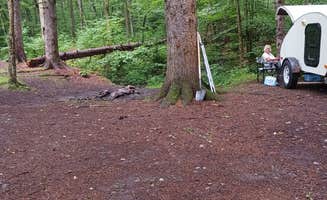Dispersed camping near Lancaster, New York offers backcountry experiences in state forests where primitive sites replace developed campgrounds. The region sits within the Allegheny Plateau with elevations ranging from 1,200 to 1,800 feet, creating varied terrain for different camping experiences. Most forest campsites require campers to pack in all necessities and practice Leave No Trace principles due to limited facilities.
What to do
Hiking the Finger Lakes Trail: Access trail segments directly from Boyce State Forest where primitive camping complements day hikes. A camper notes, "If roughing it is your thing this is primitive tent sites on a small pond located on the Finger Lake Trail."
Creek exploration: Camp Seneca provides waterside sites where campers can wade and explore. A recent visitor mentioned, "We picked the biggest site next to the creek," making it ideal for water-based activities during summer months.
Wildlife observation: Bring binoculars to spot local birds and mammals throughout the forests. Morning and evening hours typically offer the best viewing opportunities for white-tailed deer, wild turkeys, and various songbirds native to western New York woodlands.
What campers like
Natural privacy: The dispersed setup means camping without crowds. A Camp Seneca visitor reported, "We came into the area on a Monday and this camp was completely empty," highlighting the solitude possible even at more established forest sites.
Weather protection: Forest canopy provides natural shelter during inclement weather. As one camper at Camp Seneca observed, "The tree canopy over our site was dense enough that we did not get very wet when it rains."
Basic amenities at select sites: While McCarthy Hills Forest offers completely primitive camping, English Hill State Forest provides more accessible options for those seeking slightly more established sites with road access.
What you should know
Seasonal access challenges: Road conditions vary significantly by season. At Boyce State Forest, a camper warned about trail conditions: "Trail was more of a stream than a trail. You'll spend more time beside the trail than actually on it." Consider visiting during drier months.
Limited facilities: Most sites lack running water and electricity. Prepare accordingly with water containers and battery-powered lights. Portable toilets exist at some locations but not all.
Fire regulations differ: Each forest maintains different rules about campfires. McCarthy Hills Forest prohibits fires completely, while other areas permit fires in established rings only.
Tips for camping with families
Site selection priorities: Choose areas with shorter access trails for younger children. One Boyce State Forest camper recommends, "If you walk/hike 1/2 mile you will find a lean-to with fire pit and privy," which provides a good target destination for families.
Pack for unexpected weather: Temperature fluctuations can be significant. A visitor suggested, "Would recommend to come in dryer season or to bring rubber boots," after experiencing wet conditions at their campsite.
Plan bathroom solutions: Facilities are minimal. A Boyce camper humorously described finding "an 'air conditioned loo'" at their site, but many areas have no facilities whatsoever, requiring preparation for bathroom needs.
Tips from RVers
Access road limitations: Most dispersed camping areas near Lancaster have narrow, unpaved access roads unsuitable for larger RVs. Smaller campervans and truck campers have better success at sites like Camp Seneca.
Leveling challenges: Prepare for uneven terrain. One visitor to Boyce State Forest noted, "Lots of room for tents, however, most sites are not flat," a consideration equally important for smaller RVs and vans.
Emergency supplies: Cell service is unreliable in these forests. One camper mentioned finding "some emergency water" at a Boyce State Forest site, but RVers should be completely self-sufficient with water, food, and first aid supplies.


